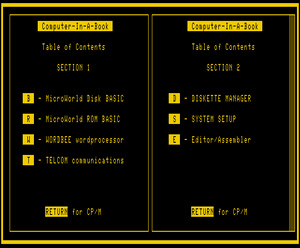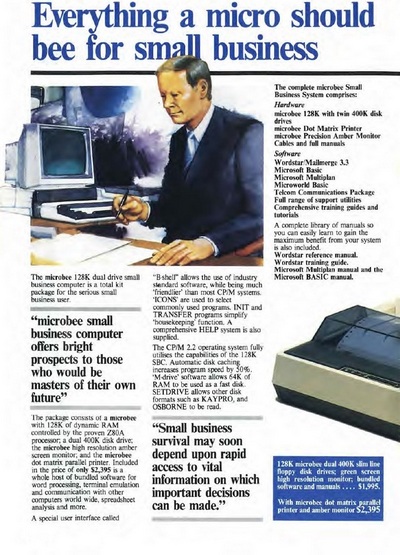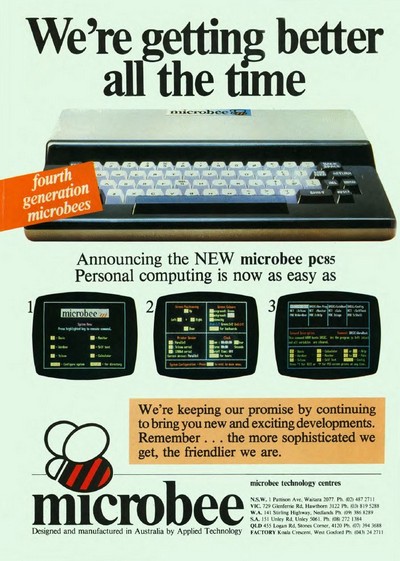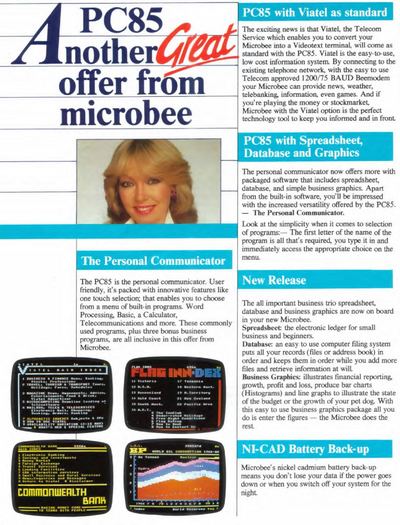Microbee Series 3 and PC85 Models
The Microbee Series 3 range, comprising the 16K Educator, 32K Communicator, 64K CIAB and 128K SBC, was released in mid 1984 and announced in Applied Technology's Online magazine in the June, July & August editions (volumes 1, 2 & 3).
A new Static RAM (SRAM) Core board (coded MB8328) was developed for Series 3 ROM based models which allows Mask ROMs to be used for Basic and WordBee instead of the previous EPROMs. Mask ROMs were cheaper, faster to program and used significantly less power than EPROMs. The board also features support for multiple on board PAK EPROMs, larger capacity SRAM and EPROM chips and a rechargable SRAM backup battery. Both 16KB and 32KB RAM configurations were available. The schematic implies that a 56KB configuration is also possible but it is not known if this configuration was ever produced. The initial version of this board supports both 2KB (type 6116) and 8KB (type 6264) SRAM chips together with 8KB (type 2764) EPROMs. A subsequent version also allows 16KB (type 27128) EPROMs to be used.
A second new Core board was also developed for Series 3 disk based models which uses Dynamic RAM (DRAM) instead of the previous SRAM. Since DRAM occupies less board space there is now room to incorporate a floppy disk controller directly on the Core board, removing the need to have this component located in the external disk unit. As a result, the disk unit now connects to the Microbee via an industry standard 34 way floppy disk port rather than the previous proprietary 50 way Microbee expansion port. The DRAM Core board is fitted with either 64KB or 128KB RAM capacity depending on model.
The PC85, a new 4th generation Microbee designed to replace the Series 3 Educator and Communicator was unveiled at the Australian Personal Computer show in Sydney in March 1985 and also announced at the same time in Online magazine volumes 9 & 10. A new hard disk version of the 128K SBC was also announced at the same time.
A new Telcom ROM (v3) was released with Series 3. This ROM introduces a Real Time Clock (RTC) facility in software that uses the 50 Hz video vsync signal as its underlying time base. The clock requires a physical connection of the vsync signal to PIO port B bit 7 and the PIO is then programmed to generate interrupts of the same frequency which the ROM then counts to keep time. The current or start time must be set manually after each power up but is preserved during a reset. This software driven clock has some unfortunate side effects due to the frequent interrupts, including distorted sound and the possibility of interference with timing sensitive operations such as serial communications and cassette operation, so may need to be switched off during those operations. The final version of the Standard Main board (number 1248-6-02W) added support for a hardware based RTC which did not suffer from these side effects. The RTC hardware that this board supports was not fitted as standard to any Series 3 or PC85 model and is not directly supported by the Telcom ROM, but could be added as an option for other software to use.
16K Educator
Overview
Name
|
Category
|
Release Date
|
Description
|
Microbee 16K Educator Series III
|
Standard
ROM based
|
July/August 1984
|
The 16K Educator is the entry level model in the Series 3 range and appears to be largely intended for use in schools. This model seems not to have been widely promoted at the time, probably indicating that the market was already moving toward the higher capacity and more capable 32K configuration.
|
Details

Microbee Series 3 Educator Brochure
|
CPU
|
Zilog Z80 @ 3.375MHz
|
RAM
|
16KB total capacity. It is unclear whether the backup battery was fitted as standard to make the RAM non-volatile.
Uses CMOS Static RAM (SRAM), eg Hitachi HM6116 (each 2KB)
|
ROM
|
A total of 72K ROM can be fitted:
- Microworld Basic (16KB). Fitted as standard.
- WordBee Word Processor (8KB). Fitted as standard.
- Telcom (8KB). Unclear if this was fitted as standard.
Uses 2x 8KB Mask ROMs (or 2x 2764 EPROMs) for Basic, 1x 8KB Mask ROM (or 1x 2764 EPROM) for WordBee and 1x 2764 8KB EPROM for Telcom.
Up to 5x additional 2764 8KB EPROMs can be fitted as optional PAK ROMs.
|
Storage
|
Cassette tape via an external recorder with a load/save speed of 300 or 1200 baud.
|
Video
|
Monochrome composite video output using an external monitor. Two main display resolutions are available:
- 64*16 characters.
- 80*24 characters.
Uses Synertek 6545 CRT controller.
|
Graphics
|
Two graphics modes available using a Programmable Character Generator SRAM (PCG):
- Low resolution (LORES):
- 128*48 pixels on a 64*16 character display.
- High resolution (HIRES):
- 512*256 pixels on a 64*16 character display.
- 640*264 pixels on a 80*24 character display.
PCG RAM capacity is 2KB, providing a maximum of 128 unique graphics characters.
|
Fonts
|
Dual fonts to support 64*16 and 80*24 character displays. Both fonts support upper and lower case characters (128 characters in total per font).
Uses a single 4KB ROM.
|
Sound
|
Internal speaker. Generates sound through software bit bashing.
|
Keyboard
|
60 key QWERTY style with a bit-paired layout.
|
Serial port
|
An RS232-like serial port using a DB25 socket at the rear. The port is configured as Data Terminal Equipment (DTE) but does not implement all RS232 standard signals and does not provide negative voltages on output. Nevertheless, it is compatible with many standard RS232 peripherals. Microworld Basic uses this port to provide 300 and 1200 baud serial communications through software bit bashing.
|
Parallel port
|
8 bit parallel I/O port via a DB15 socket at the rear.
|
Expansion interface
|
An interface to the Z80 bus is available at the rear, but the associated 50 way connector is not fitted as standard. This was available as an option.
|
DIN port
|
A 5 pin multifunction DIN socket at the rear carries:
- Power input.
- Composite video output for connection to a video monitor.
- Tape recorder output for connection to an external recorder's AUX IN/MIC socket.
- Tape recorder input for connection to an external recorder's EAR (earphone) socket.
|
System Clock
|
The master clock runs at 13.5MHz. This provides a 13.5MHz video dot clock and is divided by 4 to provide the 3.375MHz CPU clock.
|
Real Time Clock
|
Software based interrupt driven clock provided by the Telcom v3 ROM (if fitted).
An optional hardware based RTC could be fitted to the final Standard Main board.
|
Case
|
Standard
|
Power
|
12V 1A plugpack
|
|
Included Software
|
Version
|
Microworld Basic in ROM
|
5.22e
|
WordBee in ROM
|
1.2
|
Telcom in ROM (potentially)
|
3.0
|
|
|
Pricing
|
$
|
Microbee 16K Educator Series III
|
$449.00
|
|
Notes
32K Communicator
Overview
Name
|
Category
|
Release Date
|
Description
|
Microbee 32K Communicator Series III
|
Standard
ROM based
|
July/August 1984
|
The 32K Communicator is the mainstream ROM based model in the Series 3 range and appears to have been more widely promoted than the 16K Educator. The new integrated PAK ROM feature is advertised as a "Built-in Silicon Disk" and includes a new Command File ROM as standard to provide an online Microworld Basic command dictionary/help system.
|
Details

Microbee Series 3 Communicator Brochure

Microbee Series 3 Communicator Brochure
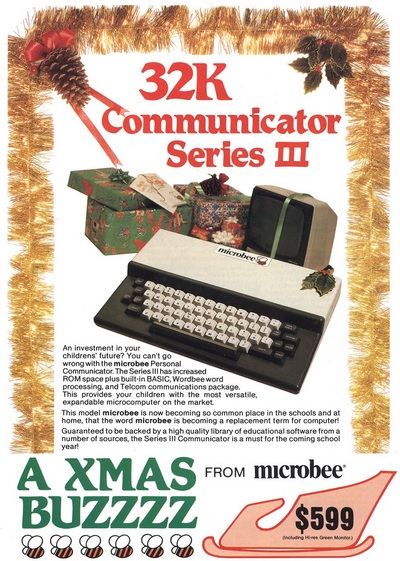
Microbee Series 3 Communicator Brochure
|
CPU
|
Zilog Z80 @ 3.375MHz
|
RAM
|
32KB total capacity. A rechargable backup battery is fitted as standard to make the RAM non-volatile.
Uses CMOS Static RAM (SRAM), eg Hitachi HM6116 (each 2KB)
|
ROM
|
A total of 72K ROM can be fitted:
- Microworld Basic (16KB). Fitted as standard.
- WordBee Word Processor (8KB). Fitted as standard.
- Telcom (8KB). Fitted as standard.
- Command File (8KB). Fitted as standard.
Uses 2x 8KB Mask ROMs (or 2x 2764 EPROMs) for Basic, 1x 8KB Mask ROM (or 1x 2764 EPROM) for WordBee, 1x 2764 8KB EPROM for Telcom and 1x 2764 8KB EPROM for Command File.
Up to 4x additional 2764 8KB EPROMs can be fitted as optional PAK ROMs.
|
Storage
|
Cassette tape via an external recorder with a load/save speed of 300 or 1200 baud.
|
Video
|
Monochrome composite video output using an external monitor. Two main display resolutions are available:
- 64*16 characters.
- 80*24 characters.
Uses Synertek 6545 CRT controller.
|
Graphics
|
Two graphics modes available using a Programmable Character Generator SRAM (PCG):
- Low resolution (LORES):
- 128*48 pixels on a 64*16 character display.
- High resolution (HIRES):
- 512*256 pixels on a 64*16 character display.
- 640*264 pixels on a 80*24 character display.
PCG RAM capacity is 2KB, providing a maximum of 128 unique graphics characters.
|
Fonts
|
Dual fonts to support 64*16 and 80*24 character displays. Both fonts support upper and lower case characters (128 characters in total per font).
Uses a single 4KB ROM.
|
Sound
|
Internal speaker. Generates sound through software bit bashing.
|
Keyboard
|
60 key QWERTY style with a bit-paired layout.
|
Serial port
|
An RS232-like serial port using a DB25 socket at the rear. The port is configured as Data Terminal Equipment (DTE) but does not implement all RS232 standard signals and does not provide negative voltages on output. Nevertheless, it is compatible with many standard RS232 peripherals. Microworld Basic uses this port to provide 300 and 1200 baud serial communications through software bit bashing.
|
Parallel port
|
8 bit parallel I/O port via a DB15 socket at the rear.
|
Expansion interface
|
An interface to the Z80 bus is available at the rear, but the associated 50 way connector is not fitted as standard. This was available as an option.
|
DIN port
|
A 5 pin multifunction DIN socket at the rear carries:
- Power input.
- Composite video output for connection to a video monitor.
- Tape recorder output for connection to an external recorder's AUX IN/MIC socket.
- Tape recorder input for connection to an external recorder's EAR (earphone) socket.
|
System Clock
|
The master clock runs at 13.5MHz. This provides a 13.5MHz video dot clock and is divided by 4 to provide the 3.375MHz CPU clock.
|
Real Time Clock
|
Software based interrupt driven clock provided by the Telcom v3 ROM (if fitted).
An optional hardware based RTC could be fitted to the final Standard Main board.
|
Case
|
Standard
|
Power
|
12V 1A plugpack
|
|
Included Software
|
Version
|
Microworld Basic in ROM
|
5.22e
|
WordBee in ROM
|
1.2
|
Telcom in ROM
|
3.0
|
|
|
Pricing
|
$
|
Microbee 32K Communicator Series III
|
$499.00
|
|
Notes
64K Computer in a Book (CIAB)
Overview
Name
|
Category
|
Release Date
|
Description
|
Microbee 64K Computer in a Book (CIAB)
|
Standard
Disk based
|
1984
|
The Microbee Computer in a Book uses the new DRAM Core board to provide a total of 64KB RAM capacity and is the first Microbee to use 3.5" floppy disks. Despite what you might think from the name, the "computer" part remains housed within the standard Microbee case just like every other model and the external "book" unit simply contains a switch mode power supply and a single 3.5" floppy disk drive. An additional floppy disk drive can be added as a separate disk unit (volume 2) that is daisy chained from the first (volume 1). Volume 2 does not contain a power supply - it is powered via a separate cable from volume 1.
CIAB Microbees may have a triangular label fixed to the bottom right corner of the top panel stating "Series 3 64K Dynamic", signifying that a 64K Dynamic RAM Core board is fitted.
|
Details

Microbee 64K Dynamic (CIAB)
|
CPU
|
Zilog Z80 @ 3.375MHz
|
RAM
|
64KB total capacity.
Uses Dynamic RAM (DRAM) with 8x 4164 RAM ICs
|
ROM
|
8KB Boot/Monitor ROM (a single 2764 EPROM)
|
Storage
|
Either:
- Single or dual half height 3.5" SSDD 80 track floppy disk (386K capacity) via separate external disk units, or
Cassette tape via an external recorder with a load/save speed of 300 or 1200 baud.
|
Video
|
Monochrome composite video output using an external monitor. Two main display resolutions are available:
- 64*16 characters (for Basic)
- 80*24 characters (for CP/M)
Uses Synertek 6545 CRT controller.
|
Graphics
|
Two graphics modes available using a Programmable Character Generator SRAM (PCG):
- Low resolution (LORES):
- 128*48 pixels on a 64*16 character display.
- High resolution (HIRES):
- 512*256 pixels on a 64*16 character display.
- 640*264 pixels on a 80*24 character display.
PCG RAM capacity is 2KB, providing a maximum of 128 unique graphics characters.
|
Fonts
|
Dual fonts to support 64*16 and 80*24 character displays. Both fonts support upper and lower case characters (128 characters in total per font).
Uses a single 4KB ROM.
|
Sound
|
Internal speaker. Generates sound through software bit bashing.
|
Keyboard
|
60 key QWERTY style with a bit-paired layout.
|
Serial port
|
An RS232-like serial port using a DB25 socket at the rear. The port is configured as Data Terminal Equipment (DTE) but does not implement all RS232 standard signals and does not provide negative voltages on output. Nevertheless, it is compatible with many standard RS232 peripherals. Microworld Basic uses this port to provide 300 and 1200 baud serial communications through software bit bashing.
|
Parallel port
|
8 bit parallel I/O port via a DB15 socket at the rear.
|
Floppy interface
|
The DRAM Core board provides a Shugart standard 34 way floppy disk interface at the rear for connecting to the external disk unit(s).
|
Expansion interface
|
The standard DRAM Core board does not provide a 50 Way Expansion interface as provided by other Core boards. An optional add-on board can be fitted to provide this if required.
|
DIN port
|
A 5 pin multifunction DIN socket at the rear carries:
- Power input.
- Composite video output for connection to a video monitor.
- Tape recorder output for connection to an external recorder's AUX IN/MIC socket.
- Tape recorder input for connection to an external recorder's EAR (earphone) socket.
|
System Clock
|
The master clock runs at 13.5MHz. This provides a 13.5MHz video dot clock and is divided by 4 to provide the 3.375MHz CPU clock.
|
Real Time Clock
|
None
|
Case
|
Standard
|
Power
|
Power is supplied from the external disk unit via a separate cable integrated into the DIN plug.
|
|
Included Software
|
Version
|
Boot/Monitor in ROM
|
bn55
|
|
Included Documentation
|
- Microbee Computer-In-A-Book Manual
|
|
Pricing
|
$
|
Microbee 64K CIAB Volume 1 (Computer and 1st external drive)
|
$995.00
|
Microbee 64K CIAB Volume 2 (2nd external drive)
|
$345.00
|
|
Notes
- A bank switching technique (port 50) is used to switch components of RAM and ROM into and out of view within the Z80 memory map. The full 64KB RAM and 8KB ROM capacity is available for use via this method.
128K Small Business Computer (SBC)
Overview
Name
|
Category
|
Release Date
|
Description
|
Microbee 128K Small Business Computer (SBC)
|
Standard
Disk based
|
June 1984
|
The Microbee Small Business Computer (SBC) uses the new DRAM Core board to provide a total of 128KB RAM capacity. The initial SBC release used dual 5.25" drives installed side-by-side into a new case that was designed to double as a monitor stand. Later SBC releases allowed either 5.25" or 3.5" drives to be used in the same case and also included a hard disk model. The SBC disk unit also contains a switch mode power supply that is used to power both drives and the Microbee.
SBC Microbees may have a triangular label fixed to the bottom right corner of the top panel stating "Series 3 128K Dynamic", signifying that a 128K Dynamic RAM Core board is fitted.
The innovative Microbee CP/M Shell has it's first introduction with the SBC. This early graphical icon-based interface makes CP/M easier and more intuitive to use and is further developed in later models.
|
Details

Microbee 128K Dynamic (SBC)

Microbee Shell (Early 1 version)
|
CPU
|
Zilog Z80 @ 3.375MHz
|
RAM
|
128KB total capacity.
Uses Dynamic RAM (DRAM) with 16x 4164 RAM ICs
|
ROM
|
8KB Boot/Monitor ROM (a single 2764 EPROM)
|
Storage
|
Either:
- Dual half height 5.25" (or later 3.5") DSDD 40 track floppy disk drives (386K capacity) via the external disk unit, or
- From March/April 1985, a single 5.25" 10MB hard disk plus a single half height 5.25" (or later 3.5") DSDD 40 track floppy disk drive (386K capacity) via the external disk unit, or
Cassette tape via an external recorder with a load/save speed of 300 or 1200 baud.
|
Video
|
Monochrome composite video output using an external monitor. Two main display resolutions are available:
- 64*16 characters (for Basic)
- 80*24 characters (for CP/M)
Uses Synertek 6545 CRT controller.
|
Graphics
|
Two graphics modes available using a Programmable Character Generator SRAM (PCG):
- Low resolution (LORES):
- 128*48 pixels on a 64*16 character display.
- High resolution (HIRES):
- 512*256 pixels on a 64*16 character display.
- 640*264 pixels on a 80*24 character display.
PCG RAM capacity is 2KB, providing a maximum of 128 unique graphics characters.
|
Fonts
|
Dual fonts to support 64*16 and 80*24 character displays. Both fonts support upper and lower case characters (128 characters in total per font).
Uses a single 4KB ROM.
|
Sound
|
Internal speaker. Generates sound through software bit bashing.
|
Keyboard
|
60 key QWERTY style with a bit-paired layout.
|
Serial port
|
An RS232-like serial port using a DB25 socket at the rear. The port is configured as Data Terminal Equipment (DTE) but does not implement all RS232 standard signals and does not provide negative voltages on output. Nevertheless, it is compatible with many standard RS232 peripherals. Microworld Basic uses this port to provide 300 and 1200 baud serial communications through software bit bashing.
|
Parallel port
|
8 bit parallel I/O port via a DB15 socket at the rear.
|
Floppy interface
|
The DRAM Core board provides a Shugart standard 34 way floppy disk interface at the rear for connecting the external disk unit.
|
Expansion interface
|
The standard DRAM Core board does not provide a 50 Way Expansion interface as provided by other Core boards. An optional add-on board can be fitted to provide this if required.
|
DIN port
|
A 5 pin multifunction DIN socket at the rear carries:
- Power input.
- Composite video output for connection to a video monitor.
- Tape recorder output for connection to an external recorder's AUX IN/MIC socket.
- Tape recorder input for connection to an external recorder's EAR (earphone) socket.
|
System Clock
|
The master clock runs at 13.5MHz. This provides a 13.5MHz video dot clock and is divided by 4 to provide the 3.375MHz CPU clock.
|
Real Time Clock
|
None
|
Case
|
Standard
|
Power
|
Power is supplied from the external disk unit via a separate cable integrated into the DIN plug.
|
|
Included Software
|
Version
|
Boot/Monitor in ROM
|
bn54?
|
|
Included Documentation
|
128K SBC
- 128K Floppy Disk System User's Manual
- Microworld 16K Basic User's Manual
- WordBee User's Manual
128K SBC Business Package
- Microbee 128K Disk System Manual
- WordStar Reference Manual
- WordStar Installation Manual
- WordStar Training Guide
- SpellStar Reference Manual
- StarIndex Reference Manual
- Microsoft Multiplan for CP/M-80
- Microsoft Basic Interpreter for CP/M-80
|
|
Pricing
|
$
|
Microbee 128K SBC Business Package, dual 5.25" drives, green screen monitor, software and manuals
|
$1995.00
|
|
Notes
- As with the CIAB, a bank switching technique (port 50) is used to switch components of RAM and ROM into and out of view within the Z80 memory map. The full 128KB RAM and 8KB ROM capacity is available for use via this method.
PC85
Overview
Name
|
Category
|
Release Date
|
Description
|
Microbee PC85
|
Standard
ROM based
|
March/April 1985
|
The PC85 is the last of the Standard ROM based Microbees to be produced and introduces a new graphical menu system that allows easy selection of built in software packages. The machine uses essentially the same hardware as the earlier 32K Communicator Series III with some software upgrades, additional bundled software packages and a new PAK ROM to provide the PC85 menu functionality. Two major versions of the PC85 were released, both of which were officially named PC85. The A/B suffix included below is for clarification purposes only.
PC85A - This version was released in March/April 1985. It uses the same Core board as the 32K Communicator and is bundled with the following software in ROM:
- PC85 System Menu/Command Menu
- Microworld Basic
- WordBee
- Telcom
- Calculator
- Monitor
- Self Test
PC85B - This version superceded the PC85A in October 1985 and was sold for the same price. It features an upgraded version of the #8328 Core board which now adds support for larger 16KB (type 27128) EPROMs to provide an additional 48KB maximum ROM capacity over the superceded board. Additional software packages in ROM are now included as standard, specifically:
- Database
- Spreadsheet (Busy-Calc)
- Graphics
- Viatel (requires an optional Viatel upgrade board to be fitted to provide a 40*24 character display)
PC85 Microbees may have a rectangular label fixed to the right side of the keyboard fascia stating "PC85".
|
Details
|
CPU
|
Zilog Z80 @ 3.375MHz
|
RAM
|
32KB total capacity. A rechargable backup battery is fitted as standard to make the RAM non-volatile.
Uses CMOS Static RAM (SRAM), eg Hitachi HM6116 (each 2KB)
|
ROM
|
The PC85A uses 8KB Mask ROMs (or 2764 EPROMs) to provide a maximum total ROM capacity of 72KB.
The PC85B uses a combination of 8KB Mask ROMs (or 2764 EPROMs) and 27128 EPROMs to provide a maximum ROM capacity of 120KB.
See the PC85 Overview section above for details of specific ROM packages that are included with each version.
|
Storage
|
Cassette tape via an external recorder with a load/save speed of 300 or 1200 baud.
|
Video
|
Monochrome composite video output using an external monitor. Two main display resolutions are available:
- 64*16 characters.
- 80*24 characters.
Uses Synertek 6545 CRT controller.
|
Graphics
|
Two graphics modes available using a Programmable Character Generator SRAM (PCG):
- Low resolution (LORES):
- 128*48 pixels on a 64*16 character display.
- High resolution (HIRES):
- 512*256 pixels on a 64*16 character display.
- 640*264 pixels on a 80*24 character display.
PCG RAM capacity is 2KB, providing a maximum of 128 unique graphics characters.
|
Fonts
|
Dual fonts to support 64*16 and 80*24 character displays. Both fonts support upper and lower case characters (128 characters in total per font).
Uses a single 4KB ROM.
|
Sound
|
Internal speaker. Generates sound through software bit bashing.
|
Keyboard
|
60 key QWERTY style with a bit-paired layout.
|
Serial port
|
An RS232-like serial port using a DB25 socket at the rear. The port is configured as Data Terminal Equipment (DTE) but does not implement all RS232 standard signals and does not provide negative voltages on output. Nevertheless, it is compatible with many standard RS232 peripherals. Microworld Basic uses this port to provide 300 and 1200 baud serial communications through software bit bashing.
|
Parallel port
|
8 bit parallel I/O port via a DB15 socket at the rear.
|
Expansion interface
|
An interface to the Z80 bus is available at the rear, but the associated 50 way connector is not fitted as standard. This was available as an option.
|
DIN port
|
A 5 pin multifunction DIN socket at the rear carries:
- Power input.
- Composite video output for connection to a video monitor.
- Tape recorder output for connection to an external recorder's AUX IN/MIC socket.
- Tape recorder input for connection to an external recorder's EAR (earphone) socket.
|
System Clock
|
The master clock runs at 13.5MHz. This provides a 13.5MHz video dot clock and is divided by 4 to provide the 3.375MHz CPU clock.
|
Real Time Clock
|
Software based interrupt driven clock provided by the Telcom v3 ROM (if fitted).
An optional hardware based RTC could be fitted to the final Standard Main board.
|
Case
|
Standard
|
Power
|
12V 1A plugpack
|
|
Included Software
|
Version
|
Microworld Basic in ROM
|
5.24e, 5.25e
|
WordBee in ROM
|
1.3, 1.3 Rel 03
|
Telcom in ROM
|
3.21
|
Calculator in ROM
|
|
Monitor in ROM
|
|
Database in ROM (PC85B only)
|
|
Spreadsheet (Busy-Calc) in ROM (PC85B only)
|
III
|
Graphics in ROM (PC85B only)
|
|
Viatel in ROM (PC85B only)
|
2.3a
|
|
Included Documentation
|
PC85A
- PC85 User's Manual
- Microbee Basic with Advanced Programmming & Reference Manual
- WordBee User's Manual (probably)
|
PC85B
- PC85 System Manual
- Microbee Basic with Advanced Programmming & Reference Manual
- Videotex Manual
|
|
Pricing
|
$
|
Microbee PC85 (either version)
|
$499.00
|
Viatel Upgrade Option
|
$49.50
|
RGB Colour Board Option
|
$100.00
|
1200/75 Baud BeeModem (Viatel compatible)
|
$189.50
|
|
Notes
- While the PC85 appears to have been sold in only one RAM configuration (32K), some testing has been performed to determine exactly how much RAM is required by each of the integrated software components. Results are:
- PC85A
- PC85 System Menu/Command Menu: Requires 3K minimum.
- Microworld Basic (5.25e): Requires 3K minimum.
- WordBee (1.3 Rel 03): Requires 3K minimum.
- Telcom (3.21): Requires 3K minimum.
- Calculator: Requires 3K minimum.
- PC85B
- PC85 System Menu/Command Menu: Requires 3K minimum.
- Microworld Basic (5.25e): Requires 3K minimum.
- WordBee (1.3 Rel 03): Requires 3K minimum.
- Telcom (3.21): Requires 3K minimum.
- Calculator: Requires 3K minimum.
- Database: Requires 32K, any less and it flashes a blank screen then exits back to the shell.
- Spreadsheet (Busy-Calc III): Requires 32K to be present or the program coded in MWB reports an array DIMension error at line 18.
- Graphics: Requires 16K minimum.
- Viatel (2.3a): Requires 8K minimum.










